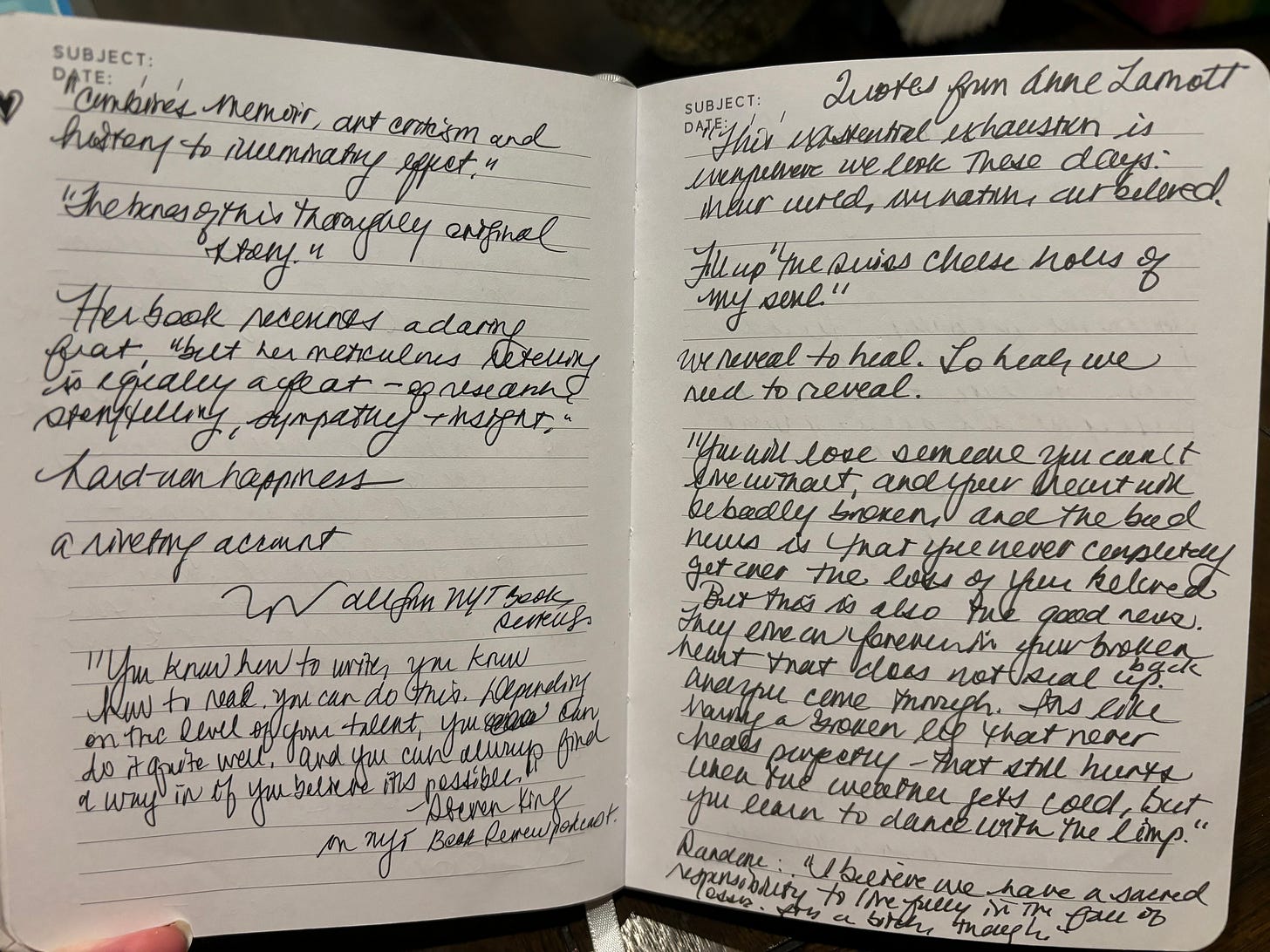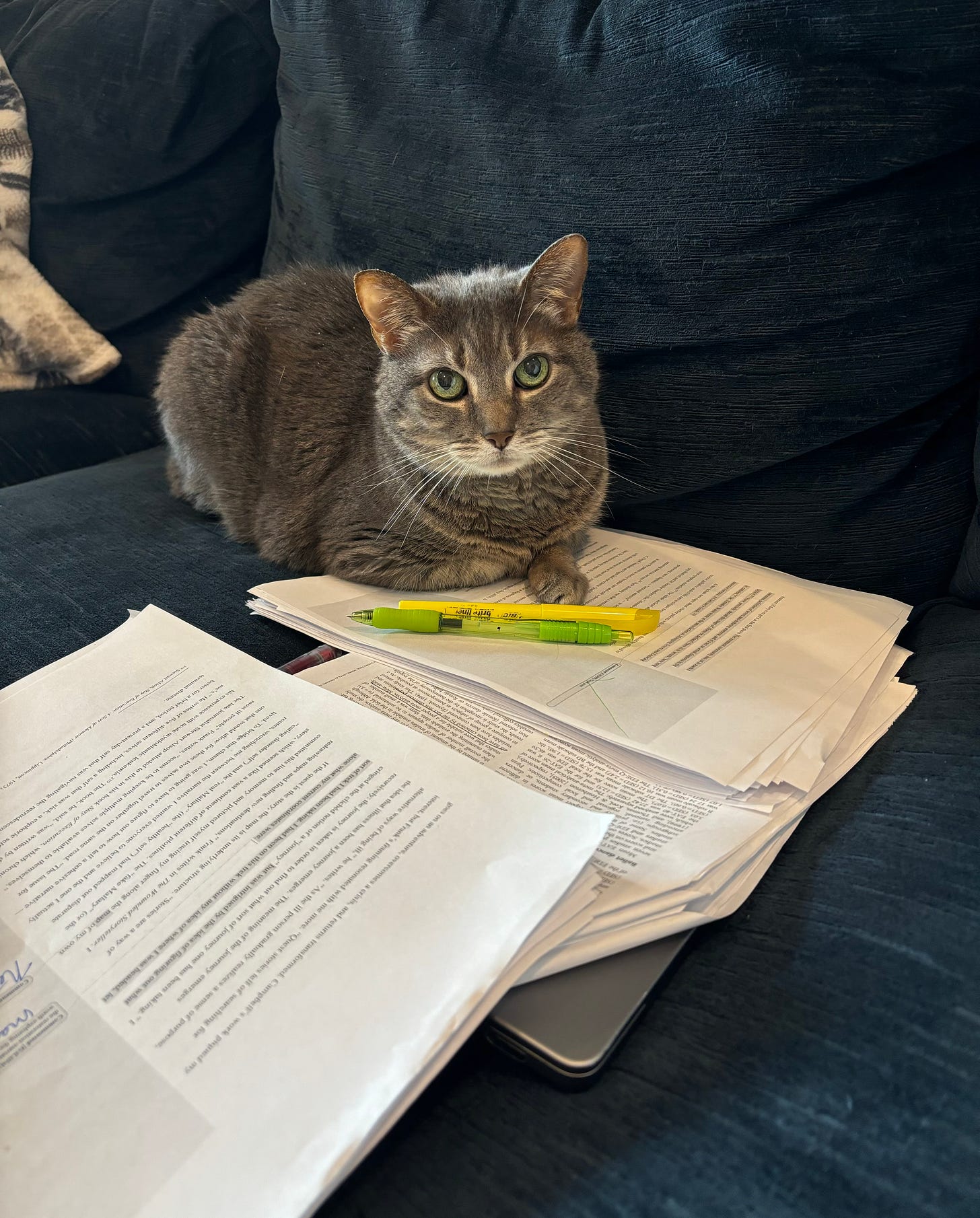Hello!
Thanks so much to everyone who subscribed to Write at the Edge last week, and to those who signed up for a paid subscription. I’m so glad you’re all part of this quickly growing community!
As you may have seen in last week’s launch post, this newsletter’s title was partly inspired by Toni Morrison’s advice to “write at the edges of the day.”
Over the years, a lot of people have asked: How do you find time to write when you have a job and two young kids? I usually picture Morrison and give them the short answer: “I wake up at 4 a.m.!” This is true, but it’s not a particularly helpful answer, and it doesn’t exactly inspire people to want to do the same. The full answer is more nuanced, and it involves a range of steps I’ve taken over the years to develop a reliable writing routine.
Here are five of those steps, which I hope you’ll find helpful.
1. KEEP A JOURNAL OR COMMONPLACE BOOK. I used to write in a daily journal during my adolescent and teenage years, sometimes penning several pages a day. I wouldn’t have called it a writing routine at the time, but it was, and it helped me grow as a writer. Once I became a journalist and started writing stories for a living, I felt as though I had no more words left to give to my journal. Journaling felt more draining than energizing, and for a while I stopped it altogether.
I’ve since picked it back up again — in a more manageable, low-stakes way. As part of my writing routine, I keep what’s known as a “commonplace book” — a collection of quotes from articles, essays, books, television shows, and movies that inspire me. Whenever I read or hear something that resonates, I jot it down, hoping other writers’ work will cultivate my own creativity.
I write in the commonplace book serendipitously, when inspiration finds me. And I do it for myself, not an audience. As Virginia Woolf once said: “The habit of writing thus for my own eye only is good practice. It loosens the ligaments.”
A page from one of my commonplace books, which includes quotes interspersed with some of my own thoughts.
2. BECOME A STUDENT AGAIN. In 2020, I decided to pursue a master’s of fine arts in nonfiction writing from Goucher College. I had two goals — to advance my academic career and to write a book — and getting an MFA seemed like a good way of achieving both.
Goucher has a low-residency program for working professionals (which ended up being “no-residency” because of the pandemic). This worked out well for me; I didn’t need to travel for week-long residencies, and all of my classes were virtual. The program — which was affordable thanks to a scholarship — provided me with the support I needed to both develop a writing routine and make meaningful progress on my book. I also met my literary agent through the program and signed on with her while I was still a student. This in and of itself made the MFA worth it.
I know MFA programs sometimes get a bad rap, but I got so much out of mine. As a professor, I naturally gravitate toward educational opportunities. But I realize that getting a master’s isn’t feasible for everyone, nor is it the best option for everyone. Online writing classes can be a worthwhile alternative. A few ideas:
MFA for All: This is a great program that makes MFA-level instruction more accessible. To quote the program’s site: “MFA for All is not a degree-granting program — it is a community-rich online educational experience led by top-notch faculty, free of the significant hurdles of time, expense, and geography that MFAs demand.” Past instructors have included Lauren Groff, Carmen Maria Machado, and Luis Alberto Urrea. Fall classes will soon be announced.
The Shipman Agency offers online craft seminars, master classes, and manuscript consultations with Sarah Manguso, Eula Biss, and other award-winning authors. The seminars and classes last different lengths of time and have different price points.
Jane Friedman, a book publishing guru, offers affordable online classes for writers and authors who want to improve their craft.
There are lots of other writing classes out there; I’d love to hear some of your go-to’s in the comments section!
3. CARVE OUT TIME EACH DAY (OR AT LEAST A COUPLE TIMES A WEEK). These pockets of time could happen during the lunch hour, while your kids are napping, through a series of short breaks, etc.
I’m not good at writing in short bursts, so I knew that to write a book, I needed longer stretches of time. I used to carve out these stretches late at night, after my family had gone to bed. But I found that I would lose track of time and stay up until 1 or 2 in the morning. It was too late for me to have a buffer between writing and bedtime, so I would go to bed wide awake. Sometimes I would toss and turn for hours, unable to stop thinking about what I had just written.
Sixteen-year-old Clara the cat keeps me company no matter what time of day I’m writing.
After several sleep-deprived months, I changed my routine. I started getting up early to write, when the house was dark and still. This wasn’t easy as a lifelong night owl, but I came to appreciate the quiet solitude of predawn mornings. I fell into what became a familiar daily routine: Wake up around 4 a.m., make myself a big cup of iced coffee (with a side of chocolate), and write for about two hours. I liked knowing that I had to stop just before 6 a.m. every morning to get myself and my kids ready for the day. Mornings offered me a built-in deadline that nighttime couldn’t. Having this deadline forced me to be more productive in the limited time I had.
I’m speaking in the past tense because I just submitted the final draft of my manuscript to my publisher last week! It now moves on to a copy editor, fact-checker, and sensitivity reader. Finishing the final draft is a big step in the process — and one that should afford me some rest. But even with this deadline behind me, I’ve still been waking up early to get work done. Once you fall into a routine that works, it’s hard to fall out of it. That said, I’m hoping more sleep is in my future!
4. PROTECT YOUR WRITING TIME. To do this, I rely on reminders and timekeepers. I put my early-morning writing time on my calendar so that I can see it as part of my daily agenda. When I’m on deadline with projects that require more bandwidth, I add extra blocks of reporting/writing time in between classes and meetings. Seeing these blocks on the calendar helps me prioritize the written word.
I also rely on hourglasses as visual aids. You can buy cheap hourglasses for various lengths of time — 15 minutes, a half-hour, an hour, etc. (I like these, as well as this one.) Seeing the hourglass on your desk can be a good reminder to start putting words on the page. When time is up, you may or may not have a lot to show for it. But you can at least feel good about the fact that you made time for it.
A few of the hourglasses in my home office.
5. DON’T END ON A PERFECT NOTE. It’s easy to want to perfect that last sentence or paragraph before you close your laptop or put down your pen. As a perfectionist, I used to try ending my writing time on a high note: a well-crafted sentence, a compelling metaphor, a solid chapter ending. But the next morning, I would have trouble getting started. I would spend thirty minutes writing two or three sentences, disrupting my routine. I eventually realized why this was happening: I had set the bar too high the day before.
I started ending my writing time on an imperfect note — an incomplete sentence, a half-baked metaphor with potential, a choppy chapter ending — and found that this gave me an easier entry point the next day. I could immediately start tinkering with the parts that needed work and then feel more productive. This technique created a sense of momentum that carried me through my writing time and has helped strengthen my routine ever since.
On Fridays, Write at the Edge poses writing-related discussions for subscribers. Tomorrow’s guiding question will be geared toward writing routines. I’d love to hear about your own strategies, so I hope you’ll join the discussion.





Love these suggestions! What time do you go to bed in order to rise at 4 AM?
Man, it's not very often I come across another fan of the Commonplace book! Mine is a bit different than yours, as I use the traditional John Locke format, but I do love the way it helps me be intentional and a wee bit organized :)